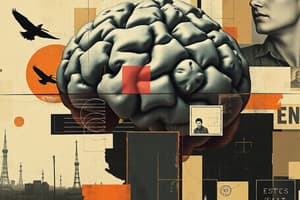Podcast
Questions and Answers
What is the main purpose of attention in cognitive processing?
What is the main purpose of attention in cognitive processing?
- To eliminate the need for short-term memory.
- To enhance perception and memory by focusing on all stimuli equally.
- To allow for maximum distraction while performing tasks.
- To filter out irrelevant information while processing significant stimuli. (correct)
Which type of attention involves concentrating on one stimulus while ignoring others?
Which type of attention involves concentrating on one stimulus while ignoring others?
- Divided attention
- Selective attention (correct)
- Sustained attention
- Focused attention
According to Broadbent's Filter Model, which stage comes first in the process of filtering information?
According to Broadbent's Filter Model, which stage comes first in the process of filtering information?
- Short-term memory storage
- Filter based on interpretation
- Sensory memory (correct)
- Detection of meaning
The 'Cocktail Party Effect' challenges which aspect of early selection models like Broadbent's?
The 'Cocktail Party Effect' challenges which aspect of early selection models like Broadbent's?
Treisman's Attenuation Model suggests that unattended information is:
Treisman's Attenuation Model suggests that unattended information is:
In late selection models like Deutsch & Deutsch, when does the filtering of stimuli occur?
In late selection models like Deutsch & Deutsch, when does the filtering of stimuli occur?
What is a common effect of divided attention when multitasking?
What is a common effect of divided attention when multitasking?
Which of the following does NOT describe a type of attention?
Which of the following does NOT describe a type of attention?
What is the main assertion of Kahneman’s Capacity Model?
What is the main assertion of Kahneman’s Capacity Model?
Which best describes automatic processing?
Which best describes automatic processing?
What does the Stroop Effect illustrate about attention?
What does the Stroop Effect illustrate about attention?
What role does the parietal cortex play in attention?
What role does the parietal cortex play in attention?
In the Feature Integration Theory, what occurs in the focused attention stage?
In the Feature Integration Theory, what occurs in the focused attention stage?
How does the Load Theory of Attention describe perceptual load?
How does the Load Theory of Attention describe perceptual load?
What is inattentional blindness?
What is inattentional blindness?
What impact does texting while driving have on attention?
What impact does texting while driving have on attention?
What characterizes Attention Deficit Hyperactivity Disorder (ADHD)?
What characterizes Attention Deficit Hyperactivity Disorder (ADHD)?
Which of the following best describes covert attention?
Which of the following best describes covert attention?
Flashcards
Attention
Attention
The ability to focus on specific information while ignoring other distracting stimuli.
Selective Attention
Selective Attention
Focusing on one task or stimulus while ignoring others.
Divided Attention
Divided Attention
The ability to split attention between multiple tasks or stimuli.
Sustained Attention
Sustained Attention
Signup and view all the flashcards
Broadbent's Filter Model of Attention
Broadbent's Filter Model of Attention
Signup and view all the flashcards
Treisman's Attenuation Model
Treisman's Attenuation Model
Signup and view all the flashcards
Cocktail Party Effect
Cocktail Party Effect
Signup and view all the flashcards
Late Selection Model
Late Selection Model
Signup and view all the flashcards
Kahneman's Capacity Model
Kahneman's Capacity Model
Signup and view all the flashcards
Automatic processing
Automatic processing
Signup and view all the flashcards
Controlled processing
Controlled processing
Signup and view all the flashcards
Stroop Effect
Stroop Effect
Signup and view all the flashcards
Overt attention
Overt attention
Signup and view all the flashcards
Covert attention
Covert attention
Signup and view all the flashcards
Spotlight model
Spotlight model
Signup and view all the flashcards
Posner's Precueing Task
Posner's Precueing Task
Signup and view all the flashcards
Parietal Cortex
Parietal Cortex
Signup and view all the flashcards
Frontal Eye Fields (FEF)
Frontal Eye Fields (FEF)
Signup and view all the flashcards
Study Notes
Attention: Overview
- Attention is a cognitive process focusing on specific stimuli while ignoring others.
- It's vital for perception, memory, and action, processing relevant information.
Types of Attention
- Selective Attention: Focusing on one task/stimulus, ignoring others.
- Divided Attention: Splitting attention between multiple tasks/stimuli.
- Sustained Attention: Maintaining focus on a task/stimulus for a long time.
Selective Attention: Filtering and Processing
- Selective attention is necessary because the environment offers more information than we can process.
- Models explain how we filter irrelevant stimuli:
Broadbent's Filter Model (Early Selection)
- Filters sensory information early, before perceptual analysis.
- Stages:
- Sensory memory (brief storage of all incoming info).
- Filter (selects info based on physical features – pitch, volume).
- Detector (processes the selected info for meaning).
- Short-term memory (holds processed info for a short time, then transfers to long-term).
Challenges to Broadbent's Model
- Cocktail Party Effect: We can hear our name in unattended conversations, showing unattended info isn't always blocked.
- Treisman's Attenuation Model: Unattended info isn't completely filtered, but attenuated (weakened). Salient information can still pass through (hearing your name).
- Late Selection Models: All stimuli are processed for meaning first, the decision to attend to something happens later.
Divided Attention: Multitasking
- Divided attention deals with processing multiple inputs or tasks simultaneously.
- Generally, multitasking reduces task performance due to limited attentional resources.
Capacity Theories of Attention
- Kahneman's Capacity Model: Attention is a limited resource, and allocation depends on task demand.
- Easier tasks can be done simultaneously.
- Demanding tasks decrease performance on both tasks.
Automatic vs. Controlled Processing
- Automatic Processing: Routine tasks needing little attention (e.g., reading, typing).
- Controlled Processing: Requires conscious attention for novel/complex tasks.
Stroop Effect
- Demonstrates the difficulty in controlling automatic processes.
- Naming ink color of words (that are color names) is harder because of the automatic process of reading.
Attention and Visual Perception
Visual Scanning and Eye Movements
- Overt Attention: Attention guided by eye movements.
- Eye movements use saccades (rapid eye movements) and fixations (pauses to process information).
- Covert Attention: Attention can be directed without moving eyes.
Spotlight Metaphor
- Visual attention is like a spotlight, shifting focus on visual scene parts, even without eye movement.
Posner's Precueing Task
- Demonstrates attention's enhancement of processing at cued locations, even without eye movement.
- Cued locations are processed more quickly.
Attention and the Brain
Parietal Cortex
- Posterior parietal cortex is crucial for shifting and focusing visual attention.
- Damage can cause hemispatial neglect (ignoring one side of space).
Frontal Eye Fields (FEF)
- Control eye movements and attention shifts.
Attention Networks
- Dorsal Attention Network: Voluntary, goal-directed attention.
- Ventral Attention Network: Involuntary, reflexive attention (e.g., responding to sudden stimuli).
Theories of Attention
Feature Integration Theory
- Visual processing has two stages:
- Preattentive stage: Automatic parallel processing of basic features (color, shape).
- Focused attention stage: Combining features to form coherent objects.
- Illusory conjunctions: Combining features from different objects when attention is overloaded.
Load Theory of Attention
- Perceptual load: Task difficulty determines attentional capacity use.
- High-load tasks use more attention, leading to less distraction.
- Low-load tasks leave more attention for irrelevant stimuli.
Attentional Failures and Disorders
Inattentional Blindness
- Failing to notice fully visible but unexpected objects when attention is elsewhere (e.g., Gorilla experiment).
Change Blindness
- Inability to detect changes in a visual scene, especially with brief interruptions.
Attention-Deficit/Hyperactivity Disorder (ADHD)
- A neurodevelopmental disorder causing inattention and/or hyperactivity.
- Individuals may struggle to sustain attention.
Everyday Applications of Attention Research
Driving and Attention
- Divided attention is dangerous in driving.
- Multitasking like texting while driving compromises performance.
Advertising
- Using bright colors, motion, novelty to attract attention.
Designing Work Environments
- Considering attention's limitations (e.g., minimizing distractions in critical tasks).
Studying That Suits You
Use AI to generate personalized quizzes and flashcards to suit your learning preferences.



